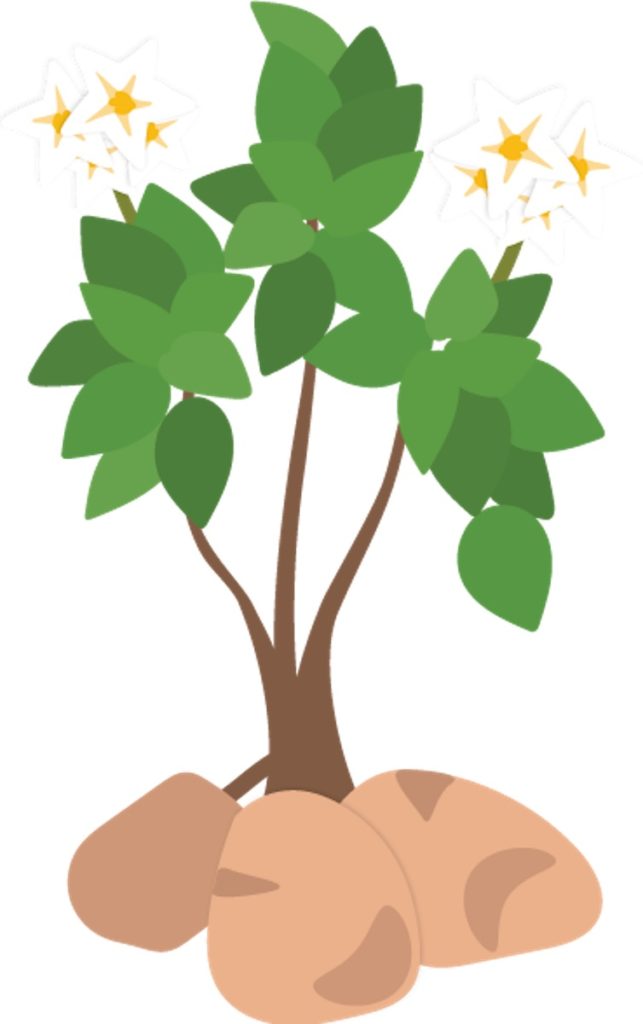 Andean Potatoes (Solanum tuberosum group andigenum)
Andean Potatoes (Solanum tuberosum group andigenum)
Overview
- Andean potatoes are considerably more diverse in form and color than modern potatoes.
- Andean potatoes are also typically smaller and lower yielding than modern potatoes.
- This crop is easy to grow in the Pacific Northwest and somewhat challenging in the much of the rest of the US.
- The tubers have a wider range of flavors than modern potatoes and flavor is often linked to flesh color.
- There are many different classifications of Andean potatoes, both taxonomic and agronomic.
- Many varieties form tubers during the short days of fall and are not ready for harvest until mid-November at the earliest.
- The crop can be propagated from tubers or true potato seeds (TPS). Growing from TPS gives you access to a wider range of types.
- Disease and pest resistance varies widely in Andean potatoes; some have poor resistance to pests and diseases that are common in North America.
About Andean Potatoes
Description
The Andean domesticated potato (primarily Solanum tuberosum group andigenum, but also S. ajanhuiri, S. curtilobum, and S. juzepczukii) forms the root of the family tree of domesticated potato. It originated in the central Andes about 10,000 years ago. Over the centuries they branched off into Chilean lowland potatoes (S. tuberosum group chilotanum), which much later were taken to Europe and became the main progenitor of the modern potato (S. tuberosum). So, in a way, you could say that the Andean potatoes are the most primitive domesticated potatoes, although this neglects the fact that the development of Andean potatoes didn’t stop when Chilean potatoes branched off. They are primitive in the sense that they are probably are closest in their traits to earlier Andean varieties.
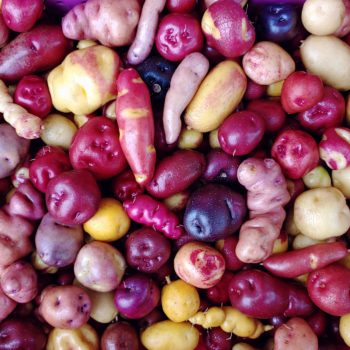
Andean potatoes are grown primarily in the middle to higher elevations of the Andes, from Venezuela south, reaching just barely into Argentina and Chile. Their center of diversity and likely origin is found from central Peru into Bolivia, but they are very common throughout the Andean countries. Although Andean potatoes just reach into Chile, there is a gap of several hundred miles between where they leave off in mountainous northern Chile and where chilotanum type potatoes evolved in central, coastal Chile. There are also populations of Andean potatoes found in the mountains of Central America as far north as southern Mexico, where they were introduced, most likely by the Spanish or possibly earlier in some cases.
One of the major differences between Andean potatoes and other groups is that the tubers do not begin to form until the day length drops to about 12 hours. This is known as short day tuberization. Andean potatoes evolved near to the equator, where the day length differs very little over the course of the year. They require at least 12 hours of darkness each day before they will form tubers. In North America, we don’t have 12 hours of darkness until after September 22nd, which means that Andean potatoes don’t form tubers until fall. This is a familiar story with Andean tuber crops; they pretty much all have the same limitation. Andean potatoes actually vary quite a bit in this trait, compared to crops like oca or ulluco; it is pretty easy to find varieties that form tubers at longer day lengths.
For varieties that are obligate short day tuberizers, the only climates suitable in North America are those that have a long, frost-free growing season extending to at least the middle of November, but better yet late December. Much of the Pacific Northwest west of the Cascades and coastal California is a suitable climate for growing Andean potatoes. That doesn’t mean that growing them is impossible in other climates, but it will take some work in either selecting for earlier tuberizing varieties or in extending the growing season by protecting the plants. In addition to frost, wet soil can be a problem for such a late harvest.
Andean potatoes have a lot of characteristics in common with the other Andean root and tuber crops, like oca, ulluco, and mashua. They have been developed to grow well in poor soils and difficult growing conditions. Many possess resistance to pests and diseases as a consequence of long exposure in the native region of the potato. They are much more diverse in color and form than modern potatoes, characteristics that we have sadly lost in the pursuit of bigger tubers and greater yields. They also have a greater range of flavors and textures than modern potatoes, including some that seem quite unfamiliar, like yellow fleshed varieties with flavors that come closer to carrot or squash than what we typically expect from potatoes.
Classification
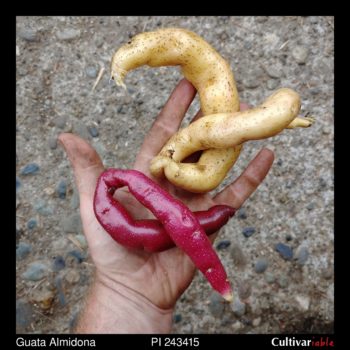
The classification of Andean potatoes is a matter of some complexity. Varieties are traditionally grouped by their agronomic characteristics, but these are phenotypic classifications. They are divided by taxonomists based on their genetic relationships and the species boundaries have changed repeatedly as the ability to determine the genotypes have improved. Both systems can be useful, but they are contradictory. The most commonly used names tend to draw from both systems of classification, which can make things a bit confusing. The two largest potato gene banks currently use different systems of classification: the International Potato Center (CIP) uses the older classification of Hawkes, in which the different ploidy levels are broken into different species, while the US Potato Genebank uses the new system of Spooner that groups all the Andean domesticated potatoes, other than the hybrid species, together into S. tuberosum group Andigenum.
With so many methods of classification, we hardly need another, but the taxonomy keeps changing, which is useful to taxonomists but confusing to everyone else. Most people growing and breeding potatoes find phenotypic classifications to be more useful than genetic divisions, so I divide Andean potatoes into five groups. These categories reflect their essential agronomic characteristics and are usually the most important divisions to growers and breeders. These divisions are based largely on ploidy: the number of homologous sets of chromosomes in a given variety. While the modern potato is almost exclusively tetraploid, Andean potatoes range from diploid to pentaploid. Tetraploids still form the majority of varieties, with diploids comprising perhaps 10 to 20% overall. The most primitive potatoes are diploids, having only two homologous sets of chromosomes, just as we do. Polyploid varieties, with more than two sets of homologous chromosomes, developed from those. The most common potatoes, both Andean and modern, are tetraploids, with four homologous sets of chromosomes.
| Various Classifications of Andean Domesticated Potatoes | |||
|
Group |
Traditional Name(s) | USDA Classification (Spooner 2014) |
CIP Classification (Hawkes 1990) |
|
High dormancy diploids Stenotomum type diploids |
|
S. tuberosum group Andigenum |
S. stenotomum subsp. stenotomum S. stenotomum subsp. goniocalyx |
|
Low dormancy diploids Phureja type diploids |
|
S. tuberosum group Andigenum |
S. phureja |
|
Andean triploids |
|
S. tuberosum group Andigenum |
S. x chaucha |
|
Andean tetraploids Andigena type tetraploids |
|
S. tuberosum group Andigenum | S. tuberosum subsp. andigenum |
| Frost resistant diploids |
|
S. ajanhuiri | S. x ajanhuiri |
| Frost resistant triploids |
|
S. juzepczukii | S. x juzepczukii |
| Frost resistant pentaploids |
|
S. curtilobum | S. x curtilobum |
High Dormancy Diploids
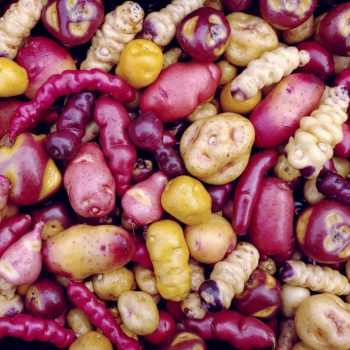
High dormancy diploids are often referred to as stenotomum type diploids; they were previously classified as Solanum stenotomum and S. goniocalyx before the taxonomy was revised and they became part of S. tuberosum group andigenum. They are found primarily in the southern half of Peru and Bolivia. They are thought to be the most primitive of the domesticated potatoes. Like low dormancy diploids, they are often small and low yielding when compared to modern potatoes. Otherwise, they can be quite different. They are generally less colorful than the low dormancy diploids, often white or dull red or blue. They have much more diversity of shape, with many having elongated, snake-like tubers or shapes with deep eyes, reminiscent of pine cones. They also have dormancy, which makes them much easier to grow in North America, although the dormancy period is generally a bit shorter than that of modern potatoes. Some have better frost resistance than modern potatoes. High dormancy diploids may lean toward the high end for glycoalkaloid content; Johns 1986b found levels ranging from 11.3 to 20.8 mg / 100 g TGA for S. stenotomum. I don’t think that most varieties really have values that high, just based on the lack of apparent bitterness I have experienced, but I don’t know of any other reported measurements. Modern potatoes usually have less than 10 mg / 100 g. There are probably less than 200 extant varieties of high dormancy diploids in the Andes.
Low Dormancy Diploids
Low dormancy diploids are often referred to as phureja type diploids because they were previously classified as Solanum phureja before the taxonomy was revised and they became part of S. tuberosum group andigenum. They mostly produce small round, compressed (round, but sort of squashed in appearance), or ovoid forms, often with deep eyes. They often have vivid skin and flesh colors. They are native to middle elevations of the eastern Andes, where the climate is suitable for growing year round. They are thought to have been selected intentionally for minimal dormancy from stenotomum type diploids so that they could be grown repeatedly throughout the year. They begin sprouting almost as soon as they are harvested and sometimes before. This is a serious limitation in North America, where low dormancy makes winter survival difficult. Even in the Andes, low dormancy diploids are more of a subsistence crop than a commercial one, although this may be starting to change as the Andean countries, particularly Peru, rediscover the value of their native crops. The low dormancy diploids may be a good source of genes for heat tolerance, given that they were traditionally grown in a warmer climate than other Andean potatoes. Although it has now been merged into S. tuberosum group andigenum, there was once a subspecies called S. phureja subsp. hygrothermicum that was described as a lowland, tropical potato of Peru. There are approximately 500 cultivars and landraces of low dormancy diploids in the Andes (NRC 1989).
Triploids
There is a small group of triploid Andean potatoes, known as chaucha (early) and previously classified as Solanum x chaucha. This is one of the least well supported groups of the old system of classification. Many of the chaucha type potatoes turned out not to be triploid after all, but even those that were grouped genetically with the rest of the diploid and tetraploid andigena type potatoes. Many of the chaucha type triploids group together in genetic analysis, but they are also interspersed with tetraploids, so it isn’t clear if they really represent a separate species and this depends largely on your concept of what a species is. Even taxonomists don’t have particularly solid agreement on where the boundaries lie between species. These triploids are not easy to distinguish from regular Andean tetraploids, other than that they rarely form berries. These varieties are interesting because triploids are not normally expected from crosses between diploid and tetraploid domesticated potatoes, although there is evidence that triploids form more commonly than has previously been recognized, with a rate of triploid formation exceeding 70% in some 4x x 2x crosses (Graebner 2019).
Tetraploids
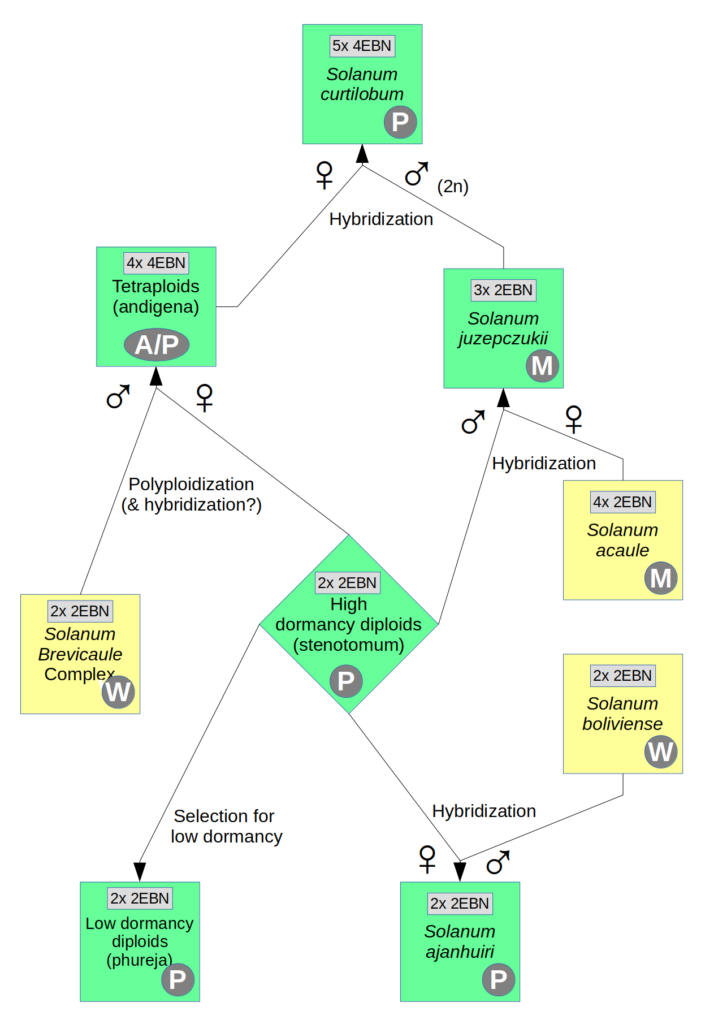 Most Andean potatoes are tetraploids, thought to have resulted from both simple polyploidization (doubling of the existing genome without hybridization) of diploid domesticated potatoes and hybridization between cultivated diploids (most likely stenotomum types) and wild potatoes with subsequent polyploidization. In other words, Andean tetraploids have probably originated more than once through different processes. There has been ongoing gene flow between Andean potatoes and wild potatoes where the coincide. Although they are often smaller than modern potatoes and adapted to short days for tuberization, they are otherwise similar in their growing and storage characteristics to modern potatoes. There are approximately 2,500 cultivars and landraces of Andean tetraploid potatoes in the Andes (NRC 1989).
Most Andean potatoes are tetraploids, thought to have resulted from both simple polyploidization (doubling of the existing genome without hybridization) of diploid domesticated potatoes and hybridization between cultivated diploids (most likely stenotomum types) and wild potatoes with subsequent polyploidization. In other words, Andean tetraploids have probably originated more than once through different processes. There has been ongoing gene flow between Andean potatoes and wild potatoes where the coincide. Although they are often smaller than modern potatoes and adapted to short days for tuberization, they are otherwise similar in their growing and storage characteristics to modern potatoes. There are approximately 2,500 cultivars and landraces of Andean tetraploid potatoes in the Andes (NRC 1989).
Frost-Resistant Hybrids (Bitter Potatoes)
Solanum ajanhuiri, S. juzepczukii, and S. curtilobum are domesticated species resulting from natural crosses between domesticated diploids and wild potatoes. S. ajanhuiri was produced from crosses with S. boliviense, S. juzepczukii from crosses with S. acaule, and S. curtilobum most likely from crossing between S. juzepczukii and domesticated tetraploids, although this last is uncertain because the cytoplasm types don’t match up. These species are grown at the upper limits of cultivation in the Andes. They have superior frost resistance, which is required at elevations where frost can occur at any time of year. They also typically have good drought tolerance because the higher elevations of the Andes are dry for most of the year. Some varieties of these species are bitter; they have high levels of glycoalkaloids. S. ajanhuiri varieties are not usually bitter, but S. curtilobum often are, and S. juzepczukii usually are. Because of this, they are generally processed into preserved forms like chuño or tunta before eating. See the Preservation section below for more information about these traditional methods of preservation.
S. juzepczukii is difficult to use for breeding, very rarely setting any seed in crosses with either diploids or tetraploids. S. ajanhuiri varieties will cross with varying degrees of success with domesticated diploids. The pentaploid S. curtilobum will cross fairly easily with tetraploid potatoes. All three species have potential to introduce more frost resistance into both Andean and modern potatoes. There are probably less than 100 extant varieties between all three of these species.
It is worth noting that, although it has not often been done, these frost-resistant hybrids can be recreated. Solanum acaule and S. boliviense both hybridize fairly readily with diploid S. tuberosum. It is possible that we could produce even more frost-resistant neo-ajanhuiri, neo-juzepczukii, or neo-curtilobum by selecting particularly resistant varieties of the respective parent species and crossing them. By starting with selections that have lower glycoalkaloids, it would also likely be possible to produce hybrids that do not require processing to render them edible.
Cytoplasm Types
Another way of classifying potatoes is by the genomes of their chloroplasts and mitochondria. Because the cytoplasmic genome is always provided by the mother and is never mixed with the paternal genome, it is easier to track across many generations. It changes very little from one generation to the next, although it evolves like any other genome over sufficiently long periods of time.
All Andean domesticated potatoes are grouped under the broad cytoplasm type M (mother), which covers the domesticated Andean species and a few wild species. Andean tetraploids are further classified mostly as type A (andigena) and a few as type P (phureja). This may provide evidence of multiple origins of Andean tetraploids, with those having P type cytoplasm arising from simple polyploidization. Andean domesticated diploids have P type cytoplasm, as does Solanum curtilobum. Solanum juzepczukii has M type cytoplasm, in common with its female progenitor S. acaule. Most wild species have variations of type W cytoplasm.
Landraces
Traditional Andean potato varieties are usually described as landraces rather than cultivars. A potato cultivar is a clonally-propagated variety, so it is genetically uniform. In contrast, a landrace would generally have a higher amount of genetic diversity. One way to look at it is that a cultivar is a representation of a particular genotype, while a landrace is a representation of a phenotype. Potato landraces happen when sexual progeny of the landrace get incorporated into the crop. For example, Andean tetraploids are usually self-fertile and set lots of berries. If those berries drop and rot, seedlings may come up. If the seedlings produce new types that are similar in appearance to the parent, they may be harvested and used to seed the next crop along with the previous types. This may may not always be recognized by the farmer. Over many years, the landrace may come to include many different genotypes that express very similar phenotypes. Some genotypes will be lost and others will take their place.
History
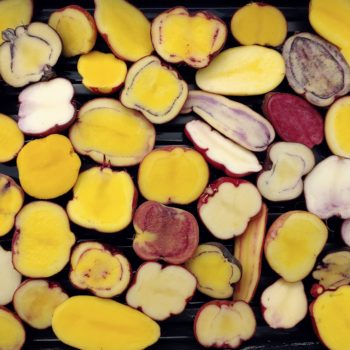
Traditional Andean agriculture is driven by different values than European and American agriculture and this is most obvious in the great diversity of forms and colors found in their cultivars and landraces. Part of the reason is practical; even in the tropics, farming in mountainous regions presents tremendous challenges. Conditions change dramatically with elevation. The ocean side of the mountains tends to be wet and the inland side dry. Temperature and moisture can vary substantially just from one side of a valley to another. This encouraged growing large numbers of varieties with different tolerances and resistances to hedge against changing conditions. Equally, the appreciation of form and color in foods appears to be a cultural value. This could be in part because it makes varieties recognizable so that those with useful traits can be easily identified and remembered, but it also appears to be a consistent motif in many areas of traditional Andean cultures. There are at least 2000 varieties of Andean potatoes and individual farmers may grow as many as 200 different varieties in a single field (NRC 1989).
Nutrition
The nutrition of Andean potatoes is generally quite similar to modern potatoes, but there are some differences. Andean potatoes are generally a bit higher in protein. This is probably due mostly to the fact that Andean potatoes are smaller, with a lower ratio of skin to flesh. Much of the protein in a potato is located in and just under the skin, so smaller tubers typically have a greater percentage of protein.
Cooking and Eating
Andean potatoes can be used just like modern potatoes, but they also come in sizes, shapes, and flavors that suggest different uses. For example, one of my favorite things to do with small diploid potatoes is to roast them whole in the skins. These bite-sized tubers pack in a lot more flavor than the large baking potatoes that most of us are more familiar with. Similarly, papas amarillas, small yellow-fleshed diploids are often used to make a delicious soup in their native countries.
Cultivation
Propagule Care
There are substantial differences in seed tuber storage requirements, depending on whether the variety has dormancy or not.
Dormant Tubers
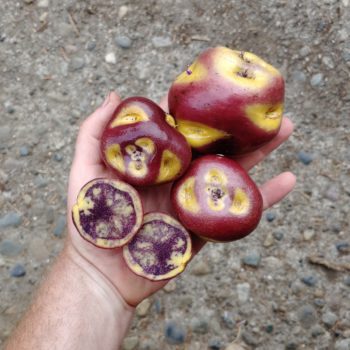
The tubers of andigena type tetraploids, high dormancy diploids, and the frost-resistant hybrid species all have dormancy and will keep similarly to modern potatoes. Store them in cool, dark conditions. Room temperature will work if you don’t have a very long winter, but the colder temperatures increase storage time. If they will be used only for seed, then the colder the better, as long as they are kept from freezing. We store seed tubers in open bins at 38F.
Non-Dormant Tubers
The tubers of low dormancy diploids may already be sprouting by the time that they are harvested. If not, they will within a few weeks. This is a serious problem for storage. There are two primary strategies for storage of non-dormant material: cold storage or light storage. I favor cold storage. I pack completely dry tubers in slightly perforated plastic bags and keep them in a refrigeration unit that holds at 35F. While the sprouts continue to grow, the low temperature slows the process down considerably. We still have heavily sprouted tubers at planting time, but as long as they are still alive, they work fine. The tubers must be dry. Storing wet tubers at low temperature can cause decay. There is a downside to very cold storage. Some of the seed tubers respond to prolonged cold, dark storage by forming emergency tubers instead of sprouts. It is important to chit the seed tubers before planting in order to eliminate those that produce tubers, since their emergence is significantly delayed. While this problem amounts to less than 10% of the stored tubers in most varieties, some varieties go into emergency tuberization at close to 100%. These varieties require an alternate storage method or they can be removed from cold storage several weeks early in order to chit the emergency tubers.
The alternative is to store the tubers under lights in cool temperature conditions, between 45 to 55 degrees if possible. Light prevents the tubers from forming long sprouts. Instead, they form short, stout sprouts with small leaves. The condition of the tubers deteriorates more quickly than under cold storage conditions, but they can survive for surprisingly long periods – as much as four months. The most significant risk of this method of storage is disease transmission. The tubers must be protected from aphids and other sap inoculating insects, which pose a much greater threat to tubers that are sprouted and closely packed.
Climate Tolerance
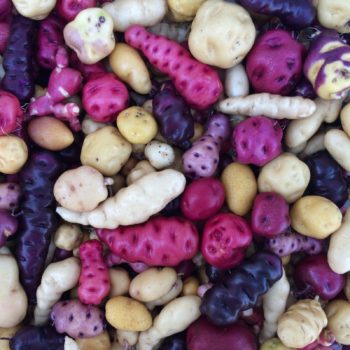
The most important climate feature for growing Andean potatoes is a long, mild autumn. Because most varieties only form tubers during short day length (after about Sep. 22), they need a sufficient frost-free period to grow. A mid-November harvest is generally sufficient to get a good yield from any of the Andean potatoes, although some yield much better with harvest a month later in December. Andean potatoes are also generally less well adapted to hot conditions than modern potatoes, although they vary substantially in this trait. Many Andean potatoes will perform poorly in climates where the temperature exceeds 80F for more than a week or two during the summer.
Photoperiod
Andean potatoes are distinguished from Chilean and modern potatoes primarily by having short day tuberization. They don’t begin to form tubers until after their critical daylength is reached. Most have a critical photoperiod of about 12 hours, which means that they won’t begin to form tubers in North America until after the autumn equinox, around September 23. After that, they need about 6 to 8 weeks to produce a good yield. This is a generalization though; there is considerable variance in critical photoperiod between varieties and other factors also interact.
There is actually quite a lot of day length variation in Andean potatoes. Based on the large number of accessions that I have grown, I would say that only about 20% are obligate short day tuberizers that simply will not form tubers until after the equinox. A much larger number begin to form tubers earlier, but don’t really yield well until after the equinox. Maybe as many as 10% appear to be effectively day neutral and happily form tubers under the long days of summer. Phureja type diploids tuberize best under long days, while stenotomum types and andigena tetraploids tend to be much more strongly short day. I have also noticed that varieties from the northern part of the Andes (Colombia and Ecuador) tend to be better long day tuberizers than those from the south (Bolivia and Argentina), which is exactly the opposite of what I would have predicted.
I think part of the explanation is that maturity eventually triggers tuberization, particularly in diploids. After about four months, many varieties will begin to tuberize even if the day length still exceeds the critical photoperiod. This, unfortunately, makes field screening for longer photoperiod tuberizers difficult, since the plants may be reaching four to five months of age at about the same time that 14 hour days arrive. But this does mean that many short day diploids will produce a reasonable yield in September when sown in April, which is easily achievable in a maritime climate.
Photoperiod affects more than just tuberization. Because tuber formation is delayed under long days, the plants grow larger than they would under tropical daylength. Internodes are longer, making stems significantly longer at the same stage of development. Many varieties also form longer stolons in summer. Flowering is not affected significantly by day length, but long days appear to provide plenty of energy to direct toward flowering. Plants typically flower more abundantly and for a longer period of time during summer and fall in North America. All of this adds up to large, often sprawling plants that take up easily twice as much space as modern varieties while producing a fraction of the tuber yield.
Planting
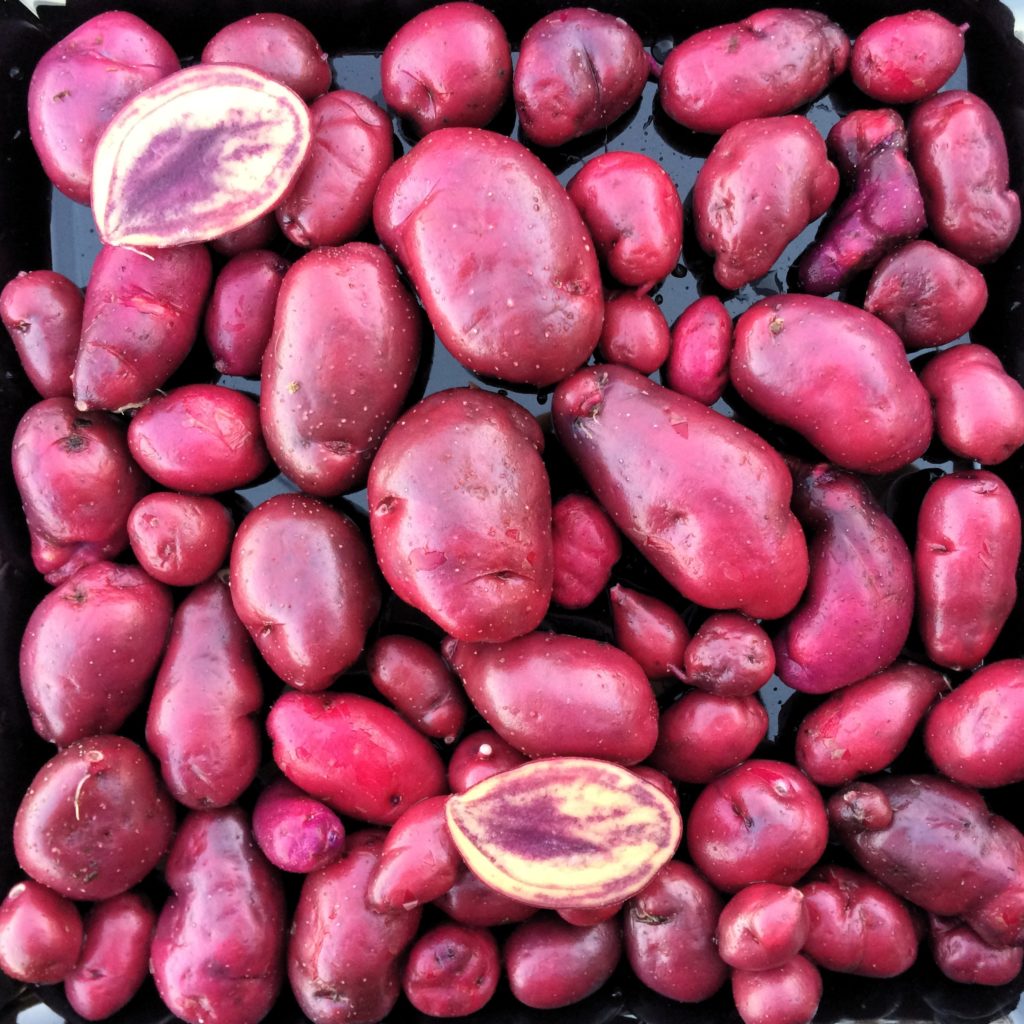
Andean potatoes are not significantly different in cultivation than modern potatoes. The differences are primarily in spacing and planting time.
In North America, you can expect most Andean potatoes to produce very large plants due to delayed tuberization as a consequence of photoperiod. For short day varieties, spacing should not be less than 24 inches in row. 48 inches between rows will often produce an unbroken canopy, while 56 inches leaves a minimum walkway. For varieties with photoperiods of 14 hours or more, spacing can be reduced to about 18 inches in row and 36 inches between rows, or even less for diploid varieties with long photoperiod.
Because most Andean potatoes will tuberize late in the growing season, planting can be delayed. In the Pacific Northwest, you can expect about the same yield from a short day potato planted any time between March and July. If you are breeding these varieties, you may benefit from earlier planting, Because most Andean potatoes flower continuously under long day conditions, earlier planting gives more opportunity to make crosses and harvest true seed.
Of course, in some cases, you don’t have many options. Low dormancy diploids generally must be planted as soon as the ground is workable, because they will be deteriorating badly after overwintering. Each diploid variety behaves a little differently. Some will produce small tubers even under long day conditions, allowing the plants to be grown through two generations before the end of the growing season. Others will not tuberize or senesce until fall, regardless of when they are planted.
Companion Planting
The sprawling, rampant growth and long growing period of short day potatoes makes them a poor choice for companion planting.
Growing as a Perennial
Potatoes typically make a poor choice for perennial growing. While they will generally overwinter successfully in fairly mild climates like the maritime Pacific Northwest, there are a lot of complications that make it a difficult proposition. One of the defining features of the domesticated potato is short stolons. Short stolons mean that the tubers are formed fairly closely together, which results in immediate overcrowding in the second generation. Wild potatoes typically have very long stolons, which results in wider spacing in subsequent generations. So, if you really want a perennial potato, it would probably be best to look at crosses between wild and domesticated types with long stolons.
Propagation
Vegetative Propagation
Vegetative propagation is the standard with potatoes. Because potato cultivars are typically genetically diverse hybrids, they can only be maintained true to type by vegetative means. The most common of these is replanting the tubers. Potatoes are also easily propagated from cuttings, so long as those cuttings are taken before the plants begin to form tubers. Micropropagation, which is essentially just the use of very small cuttings, has become the primary means of propagation for the commercial potato industry in order to maintain disease free stock.
One easy way to propagate potatoes is to remove sprouts from the tuber and plant them individually. This method is referred to by a variety of names, including pull sprouts, sprout jacking, or slips (although slips are technically a slightly different procedure traditionally used with sweet potato). Sprouts can be individually detached and rooted in pots, yielding as many plants as the tuber has eyes. Buck (1966) found that cutting the tuber into pieces produced a larger number of total sprouts, presumably due to the loss of apical dominance. Doug Strong of Windmill Hill Farms has written extensively about this method, which he has refined especially for use with low dormancy diploid potatoes. He starts tubers in shallow trays of potting soil, allowing the sprouts to root before removing them from the tuber. This method provides well rooted sprouts that can be immediately transplanted to the field. Individual sprouts produce plants with a single stem, which generally means that you will get a lower yield than you will from a small tuber or seed piece, since those will usually produce plants with more than one stem. This method is more suitable for multiplying a variety for seed tubers than for producing a food crop.
Sexual Propagation
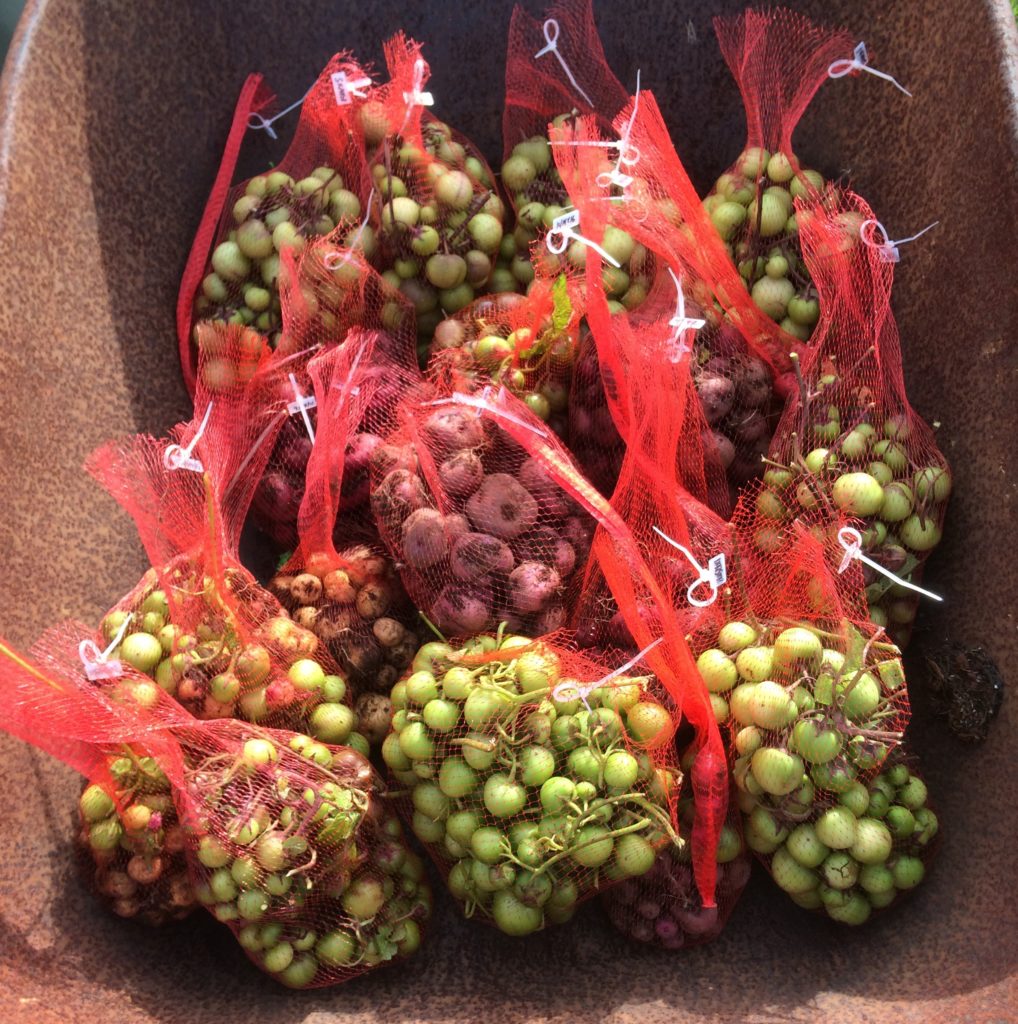
Many people who have grown potatoes from tubers for years remain unaware that potatoes can also reproduce sexually. Potatoes flower and then produce berries that can contain several hundred true potato seeds. It would be perfectly reasonable to wonder why we don’t just start potato plants from true seed then. The genetics and reproductive limitations of the potato make this a difficult proposition. Tetraploid potatoes contain four copies of the potato genome and are therefore very difficult to stabilize. This is further complicated by the fact that potato is an outbreeding crop and experiences inbreeding depression with continued self-pollination. It is much easier to maintain varieties by replanting tubers than it is to breed them to produce a stable phenotype from true seed.
There is more promise in the idea of producing diploid potatoes that are true to type from seed, but it is still a difficult challenge. Diploids are self-incompatible, so there is no prospect for stabilizing them through self-pollination. Not all diploids are strictly self incompatible though. Some appear to allow low rates of self-pollination. Still, probably not enough to form the basis of a breeding project. Potato researchers have worked around this problem by introducing a gene from the wild species, Solanum chacoense, that disables the self-incompatibility mechanism. The gene is known as Sli or “S-locus inhibitor.” The S-locus is a gene that is responsible for self-incompatibility across many plant families. Disabling self-incompatibility makes it possible to self-pollinate a diploid potato, but does not relieve the resulting inbreeding depression. With a carefully selected parent variety that has only “good” genes and few “bad” genes, it may be possible to reduce the consequences of inbreeding depression and produce a potato that comes true from seed.
Even though they don’t grow true from seed, I find that some lines of low dormancy diploids are very well suited to propagation by seed. Several lines that we have planted in bulk produce fairly uniform yields with tubers of consistent form, although varying color and flavor, while also having consistently low glycoalkaloid levels. Other than the labor involved in growing plants from seed, it seems like one could do well with a specialty market crop of seed grown diploid potatoes. The diversity of different types could easily be seen as an advantage.
Problems
There are entire books written on potato pests and diseases. I am only going to discuss here those that pose problems that are unique to Andean potatoes in North America.
Pests
In general, we have fewer potato-specific pests in North America than they do in the Andes, but a few stand out. The Colorado potato beetle can be a serious problem for even modern potatoes, but there are reports that they are particularly attracted to low dormancy diploid potatoes and can damage them severely. If you already have problems with CPB, you may find them worse with diploid potatoes.
Diseases
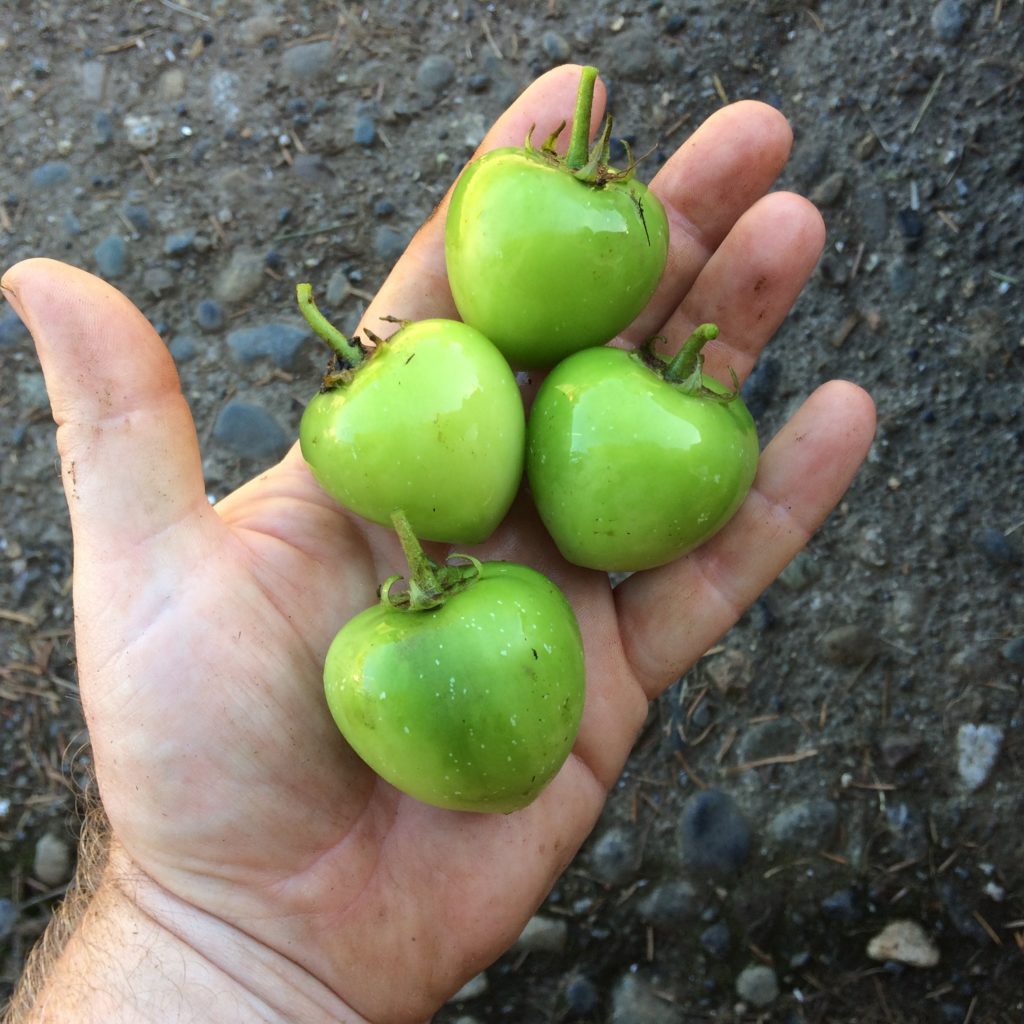
The major disease of concern when Andean potatoes in the northern hemisphere is late blight. This may be enhanced because short day tuberization requires that the plants continue growing late into the season, when cool and humid weather conditions favor the late blight organism. If you already have serious problems with late blight in modern potatoes, they are likely to be much worse with Andean potatoes. That said, Andean potatoes vary substantially in their resistance to late blight and many have a high degree of resistance that does not result from the typical R genes present in North American species and modern potato cultivars. Bachmann-Pfabe (2019) found resistance in 25% of 570 Andean potato accessions screened for late blight.
Potato leafroll virus, a common and serious potato disease in North America, may be more difficult to detect in Andean potatoes. While modern potatoes generally show upward curling leaves when infected, Andean potatoes may only show leaf chlorosis, particularly around the margins, and an unusually upright growing habit (Rodriguez 1978).
Defects
Aerial tuberization is the most commonly reported defect with Andean potatoes. Plants form small tubers, sometimes with leaves, along the lower nodes of the stems. As with so many things, this is likely a consequence of short day tuberization. By the time that the plants are ready to form tubers, the plants may be very large, producing lots of photosynthate that needs to go somewhere. In addition, high humidity late in the growing season encourages the formation of aerial tubers. Usually, this is harmless when observed late in the growing season. It can also be the result of damage to roots or stems, from pests, diseases, or poor growing conditions. Look for signs of damage around the bases of the stems to rule out a more serious problem.
Harvest
There are two major differences between harvesting Andean potatoes and modern potatoes. As discussed above, many Andean potatoes are short day tuberizers. Full yields are not achieved until mid-November or later in North America. The problem with such a late harvest is that the soil may be quite wet by that point. Selecting a site that remains high and dry through fall will make a big difference at harvest. Potatoes harvested out of muddy soil are vulnerable to all kinds of problems, ranging from handling damage to disease transmission. At minimum, they require additional effort to clean and dry before storage.
The other common challenge with Andean potatoes is that they are often too small for mechanized harvest. In the Andes, harvest is done almost exclusively by hand, so machine harvesters have not been developed that target the smaller tuber sizes. That doesn’t mean that you can’t make modifications. Small, single row harvesters can be modified with the addition of more bars to retain smaller tubers, but reducing the gap also means that soil doesn’t shake out as easily. This is particularly true if the soil will be wet at harvest, which is likely as we have already discussed. At the moment, harvesting by hand is the most practical choice for a diverse crop of Andean potatoes.
Storage
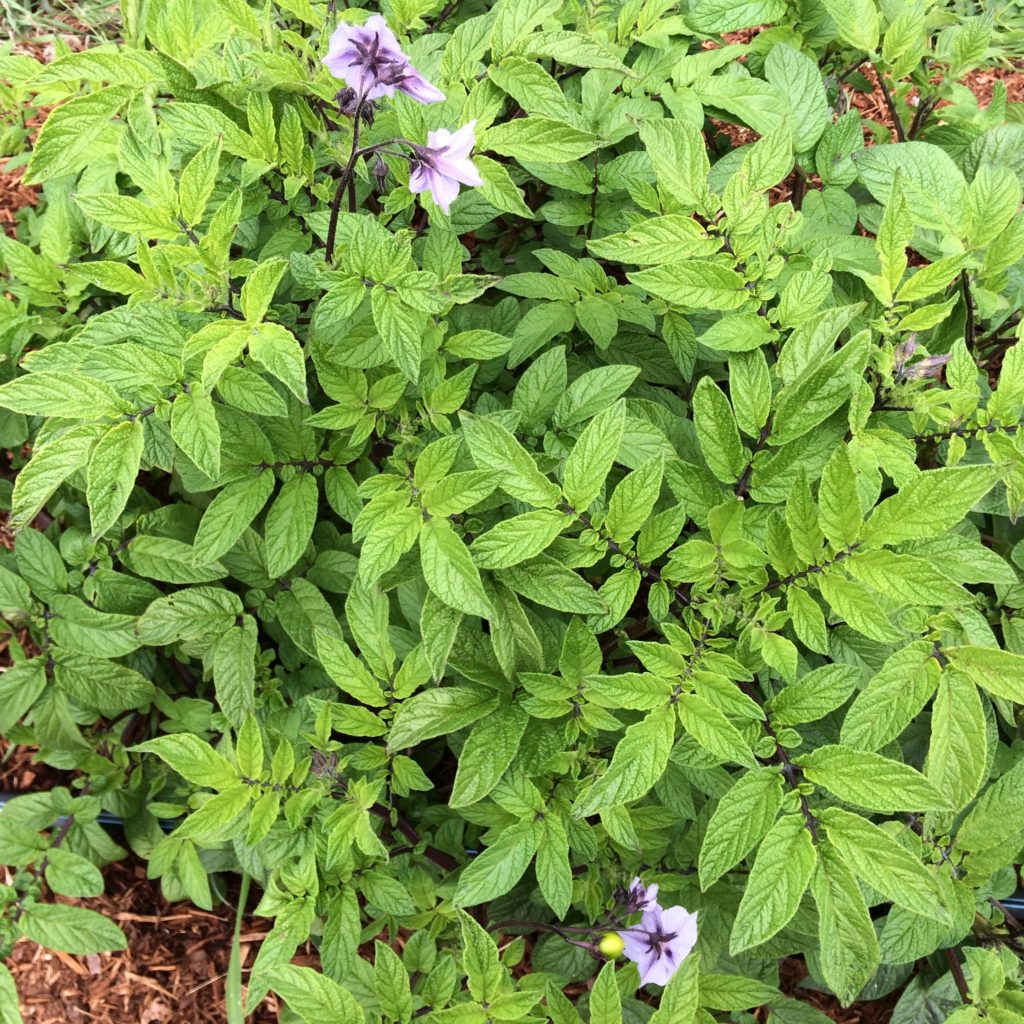
Storage of Andean tetraploid potatoes, high dormancy diploids, and the frost-resistant hybrid species is very similar to modern potatoes. Many of them don’t have quite the same level of dormancy. But most will store in good condition for market for at least three months under the same storage conditions recommended for modern potatoes. In our cooler at 38 F, these potatoes will remain in good condition for eating for most of the winter. For Andean potatoes with dormancy, you can generally expect a storage life of 4 to 5 months at 50 F or less, 2 months at 50-70 F, and less than a month at higher temperatures.
Low dormancy diploids present a much bigger problem. The best case scenario is that you get about four to six weeks of acceptable storage quality for food use. For the best storage quality, you must time the harvest of low dormancy diploids carefully. They should be dug once the tubers reach full size, but before the plants senesce. By the time you see clear signs of senescence in the plant, the tubers are likely to have already begun sprouting. The sprouts will continue to grow in storage. The sprouts can be removed, but they will eventually result in dessication of the tuber, reducing the eating quality. Determining when to harvest is an exercise specific to each variety, since maturity and photoperiod vary. For any low dormancy diploid, you should treat the first year as a calibration year, digging plants periodically to determine when they have formed good size tubers and when those tubers begin to sprout in the ground. If you maintain the same planting date, you can then dig them in following years at the same time, producing roughly the same result.
Preservation
There is no question that Andean potatoes are at their best when used for fresh eating, but the perishability of many varieties, particularly low dormancy diploids, makes a strong case for preserving the crop. All potatoes can be canned, which is an excellent way to store low dormancy types. The problem is that many Andean potatoes have deep eyes that retain soil. Because potatoes are a low acid vegetable, they require good attention to detail for canning. The problem of getting all the tubers clean is probably why we don’t see commercially canned diploid potatoes, but for home preservation, a little extra scrubbing is really no big deal.
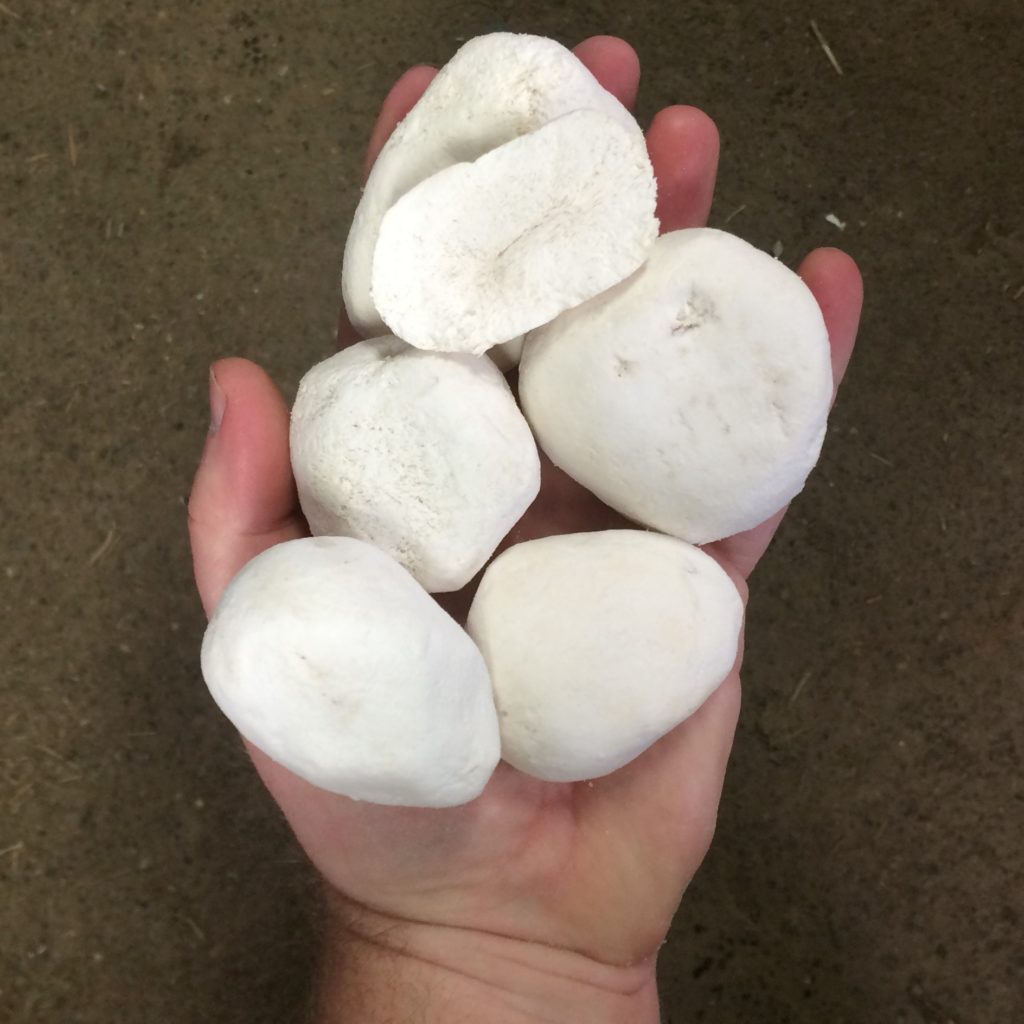
Freezing also works well, although it may take some experimentation to get it dialed in for the varieties that you are growing. For small Andean types, less than 2 inches in diameter, you can blanch the potatoes for three minutes, cool, and freeze whole in plastic bags. The trick is to blanch them just long enough so that they don’t deteriorate in the freezer, but not so long that you lose all the color. For larger tubers, you can halve or quarter them before blanching.
Traditional Andean Methods
In the Andes, there are traditional methods for preserving the frost-resistant hybrid species. These methods do not lend themselves well to climates in North America that are suitable for growing Andean potatoes because they rely on dry winter conditions. They can be replicated, of course, by using equipment to dry the potatoes.
Papa Seca
Papa seca, or dry potato, is the simpler method, used with non-bitter potatoes. Papa seca is made by boiling and peeling the potatoes, cutting them into chunks or slices, and then leaving them out in the sun to dry (Werge 1979).
Chuño
Chuño is a sort of low tech freeze-dried potato. There are quite a few different methods for making it, but they can be roughly divided into two main categories: dark chuño and white chuño. Both produce a freeze-dried potato that can be stored for years under low humidity conditions. Chuño can be soaked to rehydrate and used like fresh potatoes and is also commonly added directly to soups. It can also be ground into a kind of flour. This process requires a Goldilocks climate that is not too cold at night, too warm during the day, nor too humid at any time. Chuño is much lower in iron and protein than fresh potatoes (de Haan 2019).
Dark chuño is the simplest process but is only suitable for use with potatoes that have low glycoalkaloids. Tubers are exposed to overnight freezing temperatures and then crushed by treading or pressing on them to rupture and eventually remove the skins, allowing the water to escape. The process is repeated, freezing the tubers each night and pressing out the water each day until the tubers are hard and dry. This end product has a dark color.
White chuño, also known as tunta or moraya, is a process in which potatoes are stored in running water for several weeks before undergoing a similar process to chuño. By storing them in running water, glycoalkaloids are leached out, so this process is most commonly used with bitter potatoes. According to Guidi (2002), three or four weeks is the minimum time, but longer soaking produces a whiter product for which there is more demand. The potatoes are protected from sunlight while stored in the water to keep them from turning dark (Werge 1979). After soaking, the tubers are dried for five to ten days, depending on weather conditions and the size of the tubers (Werge 1979).
Processing for Fresh Eating
There are also similar forms of processing bitter potatoes that are not used for preservation. Qhacha chuño is prepared by freezing, thawing, and peeling the tubers and then consuming them shortly thereafter (Guidi 2002). Tocosh is similar to white chuño, but the tubers are not frozen nor dried; instead, they are soaked in running water for up to a month and then removed to eat immediately (Werge 1979). Tocosh is essentially spoiled potatoes, which have a strong odor and are said to be an acquired taste.
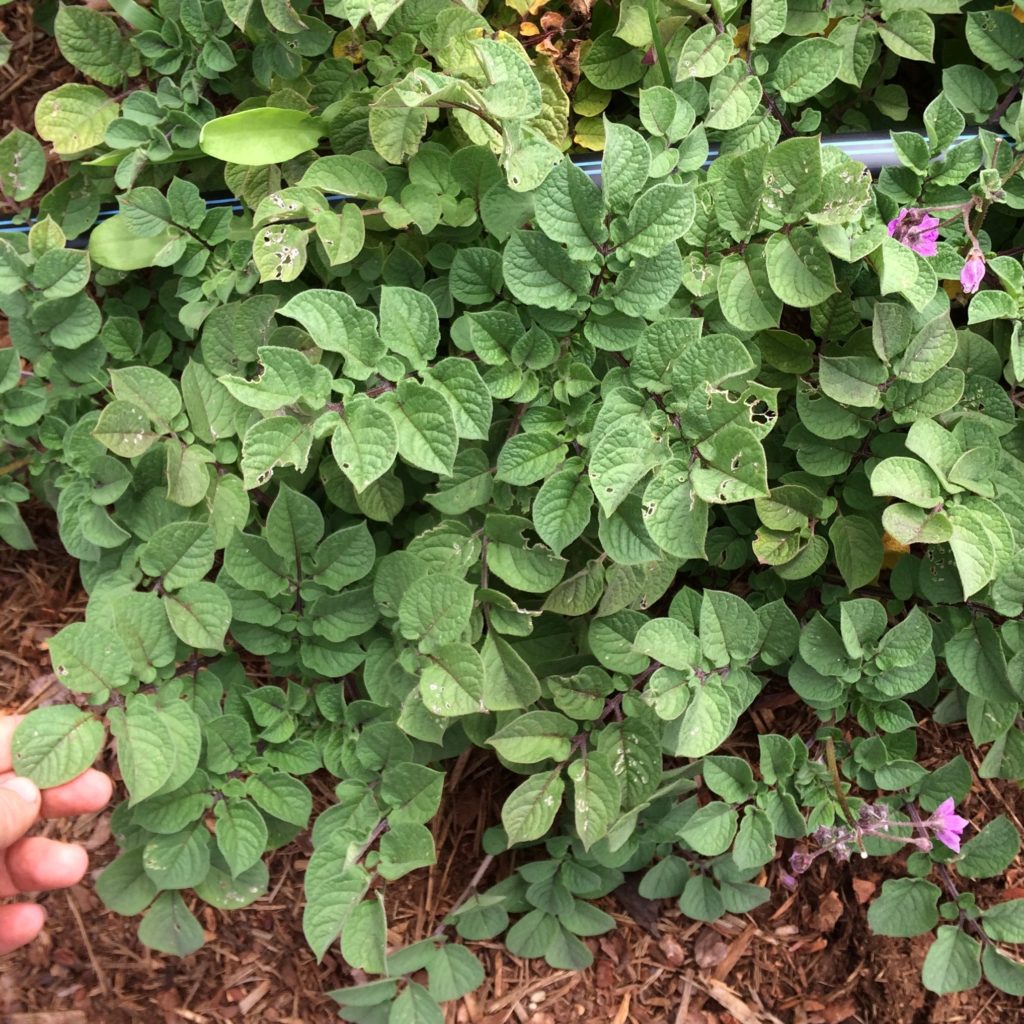
Crop Development
I know what you’re thinking. This should be an easy one, right? We have modern potatoes that are day neutral tuberizers, but perhaps a bit dull, and very exciting Andean potatoes that are, inconveniently, short day tuberizers. Obviously, we should just cross them and select for new varieties that have the unusual shapes and colors of Andean potatoes and the much more practical day neutral tuberization of modern potatoes. Unfortunately, even though they are the same species, this is difficult. Interaction between the cytoplasmic genome of Chilean and most modern potatoes and the nuclear genome of Andean potatoes results in male sterile offspring when the modern potato is used as the female parent. Crossing in the opposite direction, using the Andean potato as the female parent, can work, but is limited by the high prevalence of male sterility in modern potatoes. There are additional problems that interfere in such crosses, particularly for diploid varieties which must produce relatively rare 2n ovules to be compatible with tetraploid pollen. This can be worked around by producing modern potato haploids, but unfortunately such haploids are almost always male sterile.
Another approach to the photoperiod problem is to select for longer photoperiod from a broad genetic base of Andean potatoes. I think it is likely to be better in the long run to stick with pure Andean genetics and select back to sufficiently early varieties. Introducing male sterility is almost assured to become an obstacle as it spreads in your population. Although the success of this strategy requires that there be variation to select on and many individual lines lack this, breeding programs working with andigena types have been successful in adding several hours to the critical photoperiod in as little as six generations (Haynes 1980).
Relatives
Potatoes have a bewildering number of wild tuber-forming relatives, almost all of which can be used in breeding with Andean potatoes. The details far exceed what I could cover in this chapter. Instead, take a look at our Wild Potato Project for more information.
Learn More
Germplasm Catalogs
This is a list of germplasm catalogs for Andean potato, mostly in Spanish. They contain descriptive information about varieties that are held by South American genebanks.
Bolivia
- CATALOGO BOLIVIANO DE CULTIVARES DE PAPA NATIVA No. 2
- Catalogo de Nuevas Variedades de Papa en Bolivia
- Catalogo de variedades locales de papa y oca de la zona de Candelaria
- Catalogo Etnobotanico de Papas Nativas
- Catalogo Etnobotanico de Papas Nativas del Altiplano Norte de La Paz, Bolivia
- Papas Bolivianas – Catalogo de Cien Variedades Nativas
- Papas de Colomi
Chile
Colombia
Ecuador
Peru
- Catalogo de variedades de papa nativa con potencial para la seguridad alimentaria y nutricional de Apurímac y Huancavelica
- Catalogo de Varidades de Papa Nativa de Chuguay, La Libertad, Peru
- Catalogo de variedades de papa nativa del sureste del departamento de Junin, Peru
- Catalogo de Variedades de Papa Nativa de Huancavelica
- La Papa Nativa en Apurimac
- Las papas nativas de Canchis: Un catálogo de biodiversidad

Where can I order them?
We offer both tubers and seeds of Andean potatoes in the shop: Potatoes
Are there any varieties that would grow in northern Utah? When I was young my dad’s job took us to La Paz Bolivia for a few years. I would love to once again eat some of these wonderful potatoes!
I know very little about growing potatoes in Utah, but I would assume that you have a short growing season, which is going to be a problem for two reasons. First, many Andean potatoes don’t form tubers until the fall, so those are out. Second, many have poor dormancy, so they won’t be suitable for storage through a long winter. You might take a look at Ayock, Qoyllu, and Skagit Valley Gold, which have shorter growing seasons and fair to good dormancy. You might also consider true potato seed of high dormancy diploids and of Solanum curtilobum, both of which have traits that should turn out some suitable progeny for that climate.
What time of year is best to order seed that is fully available? And in Southern California, what varieties would you recommend? Thanks.
There is never really a moment when everything is in stock, but December is usually when the majority of roots and tubers are freshly harvested. If you live in a mild part of SoCal, then any variety should do reasonably well. If you regularly see triple digit temperatures and have baked adobe soil, then probably none of them will do very well. If your conditions are harsh, try growing from true seed, because you will be a little more likely to find varieties that can tolerate your conditions.
What varieties do you recommend for the Northern sector of the Pacific NW, close to the water? Thank you!
Since that is where I grow them, pretty much anything in the catalog!
I’m a novice gardener, new to Andean potatoes, growing I’m currently growing in an indoor garden in my apartment. I’m currently some of the “breeding seconds” inn 5gal garden bag. It is certainly not without complications, but it does come with the added benefit of controlling the day length.
My question is: How long should I let the plants grow before I give them shorter days. My experience with photoperiods is from other species that required a longer time in a vegetative state. Should I be giving these guys 12 light / 12 dark from the get go?
Thanks!
I have my Andean tubers set in an egg carton under a grow light, but they don’t seem to be forming sprouts. How long should I expect to wait for that to happen? Thank you!
It is better if they don’t dry out, as they might under lights. Best practice to wake them up quickly would be to pot them shallowly in some damp soil.
What andean potatoes would be best suited to grow in Egypt and can sample orders could be made?
What kind of potato resembles an egg? I heard it mentioned once while I was in Peru but now can’t find anything on it!
You might be thinking of Yema de Huevo, which is an example of the small, yellow fleshed, diploid potatoes broadly classified as Papa Amarilla. Yema de Huevo is not a good choice for North America due to lack of dormancy, but Skagit Valley Gold is a very good alternative, similar in flavor, texture, and color, but with some dormancy.
Hi Bill,
I went to La Cancha market at Cochabamba Bolivia and bought every possibly variety of local potatoes. I took back 6 or 7 sorts of Andean potatoes.
Last year I planted them end of may, some of them had very long time of dormancy and started to grow only in august. Last year i got hot and rainy end of summer, most of tubers were rotten.
I started this year them again as very small potatoes, They did very well this year.. Generally they have longer vegetation period than potatoes what we grow traditionally. They are more vigarous, I noticed in Bolivia that they plant potatoes with much bigger space tan Europe, as they grow much taller.
I harvested at this time 3 varieties, crop was pretty good, other 4 varieties look like they finish vegetation, i will harvest them within a week.
From my observation Bolivia potatoes make suckers, what I never seen to our traditional potatoe varieties.
I still need to build up a stock, and I havent tried how they taste..
Some varieties of Bolivia potatoes have taste what will be considered not good at my country. Some Bolivia potatoes have very good taste.
You will see sucker like growth because those potatoes probably have a short day photoperiod and will not begin to form tubers until later in the growing season. Instead, they will form indeterminate top growth with many lateral branches.
Please be cautious with those potatoes. Bolivian potatoes are almost certain to be infected with diseases that do not exist in your country and the plant health authorities can be unforgiving. If you are determined to keep them, it would be a good idea to collect seeds from them and then destroy the tubers. Even that is not a certain way to avoid disease, but the risk is less.